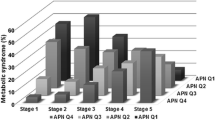Abstract
Myonectin is a newly discovered myokine correlated with diabetes. Diabetic nephropathy (DN), which is diagnosed according to albuminuria, is one of the most common microvascular complications of diabetes. Albuminuria predisposes to future cardiovascular diseases and mortality. The aim of this study is to assess the association between serum myonectin concentrations with DN. A total of 188 patients with type 2 diabetes (T2DM) and 66 control subjects were enrolled in this investigation. T2DM patients were divided into three groups: normoalbuminuria (n = 84), microalbuminuria (n = 70), and macroalbuminuria (n = 34) according to urine albumin-to-creatinine ratio (ACR). T2DM patients showed lower serum myonectin concentrations compared with the controls. Serum myonectin concentrations were significantly decreased in macroalbuminuria group than in normoalbuminuria and microalbuminuria groups. In addition, microalbuminuria group had decreased serum myonectin concentrations compared with normoalbuminuria group. Logistic regression analysis demonstrated a correlation between serum myonectin and a decreased risk of T2DM and DN. Simply linear regression analysis indicated serum myonectin was negatively correlated body mass index (BMI), total cholesterol, low-density lipoprotein cholesterol, blood urea nitrogen, creatinine, uric acid, and ACR, and positively correlated with glomerular filtration rate, insulin treatment. BMI, ACR, and insulin treatment were still correlated with the serum myonectin after a multiple linear regression analysis. Our investigation indicates serum myonectin is decreased in DN patients and correlated with renal function.

Similar content being viewed by others
Data availability
Data are available upon reasonable request.
References
Jansson SP, Fall K, Brus O, et al. Prevalence and incidence of diabetes mellitus: a nationwide population-based pharmaco-epidemiological study in Sweden. Diabet Med. 2015;32:1319–28.
Souweine JS, Corbel A, Rigothier C, et al. Interest of albuminuria in nephrology, diabetology and as a marker of cardiovascular risk. Ann Biol Clin (Paris). 2019;77:26–35.
Uchida J, Machida Y, Iwai T, et al. Low-grade albuminuria reduction with angiotensin II type 1 receptor blocker in renal transplant recipients. J Nephrol. 2011;24:515–21.
Perkovic V, Verdon C, Ninomiya T, et al. The relationship between proteinuria and coronary risk: a systematic review and meta-analysis, Version 2. PLoS Med. 2008;5:e207.
Kakio Y, Uchida HA, Takeuchi H, et al. Diabetic nephropathy is associated with frailty in patients with chronic hemodialysis. Geriatr Gerontol Int. 2018;18:1597–602.
Eppens MC, Craig ME, Cusumano J, et al. Prevalence of diabetes complications in adolescents with type 2 compared with type 1 diabetes. Diabetes Care. 2006;29:1300–6.
Yan ST, Liu JY, Tian H, Li CL, Li J, Shao YH, Shi HY, Liu Y, Gong YP, Fang FS, Sun BR. Clinical and pathological analysis of renal damage in elderly patients with type 2 diabetes mellitus. Clin Exp Med. 2016;16:437–42.
Seldin MM, Peterson JM, Byerly MS, Wei Z, Wong GW. Myonectin (CTRP15), a novel myokine that links skeletal muscle to systemic lipid homeostasis. J Biol Chem. 2012;287:11968–80.
Lim S, Choi SH, Koo BK, et al. Effects of aerobic exercise training on C1q tumor necrosis factor α-related protein isoform 5 (myonectin): association with insulin resistance and mitochondrial DNA density in women. J Clin Endocrinol Metab. 2012;97:E88–93.
Li Z, Yang YL, Zhu YJ, et al. Circulating serum myonectin levels in obesity and type 2 diabetes mellitus. Exp Clin Endocrinol Diabetes; 2019 Jul 24.
Li K, Liao X, Wang K, et al. Myonectin predicts the development of type 2 diabetes. J Clin Endocrinol Metab. 2018;103:139–47.
Zhang Y, Liu C, Liu J, et al. Implications of C1q/TNF-related protein superfamily in patients with coronary artery disease. Sci Rep. 2020;10:878.
ShokoohiNahrkhalaji A, Ahmadi R, Fadaei R, Panahi G, Razzaghi M, Fallah S. Higher serum level of CTRP15 in patients with coronary artery disease is associated with disease severity, body mass index and insulin resistance. Arch Physiol Biochem. 2019. https://doi.org/10.1080/13813455.2019.1675713.
Otaka N, Shibata R, Ohashi K, et al. Myonectin is an exercise-induced myokine that protects the heart from ischemia-reperfusion injury. Circ Res. 2018;123:1326–38.
Sun YM, Su Y, Li J, Wang LF. Recent advances in understanding the biochemical and molecular mechanism of diabetic nephropathy. Biochem Biophys Res Commun. 2013;433:359–61.
VasanthRao VR, Tan SH, Candasamy M, Bhattamisra SK. Diabetic nephropathy: an update on pathogenesis and drug development. Diabetes Metab Syndr. 2019;13:754–62.
Aghadavod E, Khodadadi S, Baradaran A, Nasri P, Bahmani M, Rafieian-Kopaei M. Role of oxidative stress and inflammatory factors in diabetic kidney disease. Iran J Kidney Dis. 2016;10:337–43.
Barutta F, Bruno G, Grimaldi S, Gruden G. Inflammation in diabetic nephropathy: moving toward clinical biomarkers and targets for treatment. Endocrine. 2015;48:730–42.
Peterson JM, Mart R, Bond CE. Effect of obesity and exercise on the expression of the novel myokines, myonectin and fibronectin type III domain containing 5. PeerJ. 2014;2:e605.
Little HC, Rodriguez S, Lei X, et al. Myonectin deletion promotes adipose fat storage and reduces liver steatosis. FASEB J. 2019;33:8666–87.
Funding
No funding.
Author information
Authors and Affiliations
Corresponding authors
Ethics declarations
Conflict of interest
The authors declare that there is no conflict of interest regarding the publication of this article.
Ethics approval
This study was approved by the Ethics Board of Qilu Hospital of Shandong University (Qingdao).
Additional information
Publisher's Note
Springer Nature remains neutral with regard to jurisdictional claims in published maps and institutional affiliations.
Rights and permissions
About this article
Cite this article
Zhang, J., Hu, W., Lin, P. et al. Decreased serum myonectin concentrations in diabetic nephropathy patients. Clin Exp Med 20, 601–607 (2020). https://doi.org/10.1007/s10238-020-00654-z
Received:
Accepted:
Published:
Issue Date:
DOI: https://doi.org/10.1007/s10238-020-00654-z




